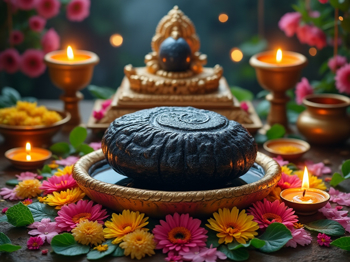



Shaligram Puja is a deeply revered and ancient ritual in Hinduism, primarily dedicated to the worship of Lord Vishnu. The Shaligram is a sacred stone, typically found in the Gandaki River in Nepal, that is believed to embody the divine presence of Lord Vishnu. This black fossilized stone is not just a symbol but is considered a direct manifestation of the deity, making the puja an important spiritual practice for devotees. Shaligram Puja is often performed to seek the blessings of Vishnu for protection, prosperity, and spiritual well-being.

Divine Manifestation: The Shaligram stone is believed to be a physical representation of Lord Vishnu, making the puja a direct connection to the deity. It is considered highly auspicious and powerful, capable of bringing divine energy into the household.
Vedic Tradition: The worship of Shaligram is rooted in ancient Vedic traditions. It is mentioned in various scriptures, including the Puranas, which highlight its importance in rituals and the benefits of performing Shaligram Puja.
Protection from Negativity: The puja is said to offer protection from negative energies, evil influences, and misfortunes. Devotees believe that keeping a Shaligram in the home creates a shield of divine protection.
Spiritual Elevation: Worshiping the Shaligram is a path to spiritual growth and enlightenment. It is believed to help devotees transcend material desires and focus on their spiritual journey.
Brings Prosperity and Wealth: Performing Shaligram Puja is believed to attract wealth, prosperity, and financial stability. It is often done by those seeking success in business or careers.
Ensures Harmony in Relationships: The puja is said to foster peace, harmony, and understanding in relationships, particularly within the family. It promotes love, respect, and unity among family members.
Removes Obstacles: Shaligram Puja helps in removing obstacles and challenges in life. It is often performed to seek divine intervention in overcoming difficulties and achieving goals.
Provides Health Benefits: The divine blessings from the puja are believed to promote good health and well-being. It can also be performed to seek healing and recovery from illnesses.
Spiritual Growth: Regular worship of the Shaligram enhances spiritual growth, bringing the devotee closer to the divine and helping in attaining moksha (liberation from the cycle of birth and death).
Protects Against Negative Influences: The presence of a Shaligram in the home and the performance of its puja is believed to ward off negative energies, evil eyes, and any malevolent forces.
Promotes Mental Peace and Stability: The spiritual vibrations generated through Shaligram Puja can calm the mind, reduce stress, and promote mental peace and stability, leading to a more balanced and fulfilling life.
Performing Shaligram Puja is a sacred and revered ritual that should be done with devotion and purity. Here's a step-by-step guide to performing the puja:
Choose an Auspicious Day: Consult the Hindu calendar (Panchang) to select an auspicious day for the puja, such as Ekadashi, Purnima, or any day dedicated to Lord Vishnu.
Cleanse Yourself and the Puja Area: Take a bath to purify yourself. Clean the area where the puja will be performed. Ensure that the puja space is free from clutter and is sanctified.
Gather Puja Materials: Collect all the necessary items for the puja, including:
Place the Shaligram: Place the Shaligram on a clean cloth in the puja area. Ensure the stone is treated with utmost respect, as it is considered a direct manifestation of Lord Vishnu.
Sprinkle Water: Sprinkle Ganga Jal on yourself, the Shaligram, and all puja items to purify them.
Invoke Lord Vishnu: Light a lamp and incense sticks. Begin by chanting mantras to invoke Lord Vishnu, such as the Vishnu Gayatri Mantra or the Om Namo Bhagavate Vasudevaya mantra.
Panchamrit Abhishekam: Pour Panchamrit (a mixture of milk, yogurt, honey, ghee, and sugar) over the Shaligram while chanting mantras or the Vishnu Sahasranama (the 1000 names of Lord Vishnu).
Ganga Jal Abhishekam: After the Panchamrit, cleanse the Shaligram with Ganga Jal to wash away the Panchamrit.
Dry the Shaligram: Gently dry the Shaligram with a clean cloth after the abhishekam.
Apply Chandan: Apply sandalwood paste (Chandan) on the Shaligram as a symbol of respect and devotion.
Offer Tulsi Leaves: Place fresh Tulsi leaves on or around the Shaligram. Tulsi is highly sacred and is considered dear to Lord Vishnu.
Offer Flowers and Incense: Offer fresh flowers to the Shaligram while chanting prayers. Light incense sticks and wave them in front of the Shaligram as an offering.
Perform Aarti: Light a ghee lamp and wave it in a circular motion before the Shaligram while singing or chanting the Vishnu Aarti. This signifies the dispelling of darkness and ignorance.
Offer Prasad: Place fruits, sweets, and other offerings (Prasad) in front of the Shaligram as a sign of gratitude and devotion.
Final Prayers: Conclude the puja by chanting the Vishnu Sahasranama or other devotional prayers dedicated to Lord Vishnu. Seek blessings for peace, prosperity, and spiritual growth.
Circumambulation (Pradakshina): If possible, perform three or more rounds of circumambulation around the Shaligram, symbolizing your devotion.
Distribute Prasad: After the puja, distribute the Prasad among family members and devotees present.
Maintain Reverence: Keep the Shaligram in a clean and sacred place after the puja, ensuring that it is treated with continued respect and devotion.
By following these steps with devotion and purity, one can perform Shaligram Puja and seek the divine blessings of Lord Vishnu.